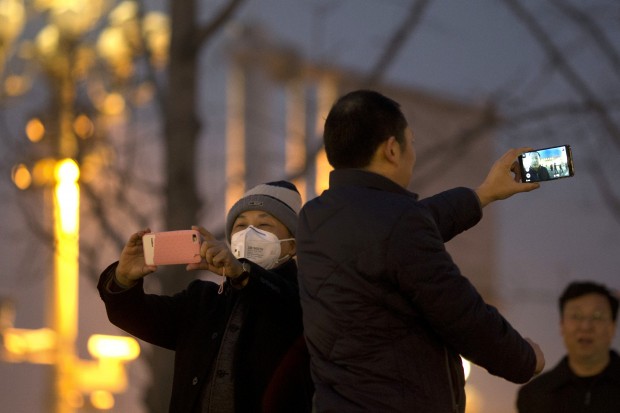Beijing lifts smog red alert

A man wears a mask to protect against the pollution as he takes a selfie in Beijing, China, Wednesday, Dec. 9, 2015. Unhealthy smog hovered over downtown Beijing as limits on cars, factories and construction sites kept pollution from spiking even higher Wednesday, on the second of three days of restrictions triggered by the city’s first red alert for smog. (AP Photo/Ng Han Guan)
BEIJING — Beijing’s first ever red alert for smog was lifted Thursday, as blue skies and sunshine replaced the thick haze that covered the city for days.
The Chinese capital put its air pollution emergency plan into action earlier this week, pulling half of all private vehicles off the streets from Tuesday, ordering many factories to close and recommending that some schools allow students to remain home.
The measures were being lifted from midday Thursday, according to a social media post by Beijing’s environmental protection bureau.
The red alert, the highest tier of a four-color warning system, came as heavy smog flooded the city for the second time in as many weeks.
The unprecedented move followed scathing public criticism aimed at the city’s weak response to last week’s thick haze, which saw pollution skyrocket to levels not seen in years.
Article continues after this advertisementCounts of PM2.5 — harmful microscopic particles that penetrate deep into the lungs — reached well over 600 micrograms per cubic meter last week, according to the US embassy, which issues independent readings, and were regularly above 300 in recent days.
Article continues after this advertisementBy Thursday afternoon they were down to as low as 15 at times as moderate winds blew from the north, below even the World Health Organization’s recommended maximum exposure of 25.
In a note posted online, the city wrote that the emergency measures had “been effective in slowing down the process of smog accumulation”, and expressed its “heartfelt thanks” and “sincere tribute” for residents’ contributions to the effort.
The city will “fight well a hard battle to prevent and contain air pollution”, it said.
But the struggle is largely out of municipal officials’ hands since much of its air pollution comes from neighboring areas, where pollution levels remained hazardous Thursday, particularly to the south in Hebei province.
One traveler on a high-speed train from the capital to the central province of Hubei posted on social media: “Every city in north China that I passed was covered by smog and looked like a dead town.
“Handan was particularly grave. Smog is absolutely not a problem only for Beijing but has truly extended into the land in north and central China. I really feel pained by that.”
Hospital visits
The recurrent bad air has driven Beijing residents to hospitals in growing numbers, according to a report on Internet giant Tencent’s news portal.
During the last month’s periods of severe pollution, it said, trips to medical facilities using hailing app Didi Kuaidi — backed by Tencent — went from 3.4 percent of all journeys to 4.1 percent, an increase of more than a fifth.
The report also cited online retailer JD.com as saying pollution mask sales soared by as much as 400 percent in response to the bad air.
Data from Chinese e-commerce giant Alibaba showed searches for air purifiers and masks being made more frequently in several areas hit by heavy pollution this month than elsewhere. Higher condom search frequencies overlapped in places, possibly as residents stayed indoors.
The miasma came as President Xi Jinping attended a critical meeting on climate change in Paris, a potentially embarrassing coincidence that underscored China’s struggle to control the pollution that contributes to both its chronic smog and global warming.
Most of the country’s greenhouse gas emissions come from the burning of coal for electricity and heating, particularly when demand peaks in winter, which is also the key cause of smog.
The chronic haze blanketing northeastern China earlier this month was so thick that, unlike the Great Wall, it could be seen from outer space, according to satellite photographs from NASA.
China’s meteorological bureau has said it expects at least one and possibly two more bouts of heavy pollution in December, with the first expected as soon as Saturday.
It remains unclear how Beijing will respond to future airborne smog peaks, but other cities in the region followed its lead this week by issuing their own red alerts as pollution levels climbed even higher than those seen in the capital.
RELATED STORIES
Unhealthy smog hovers over Beijing on Day 2 of smog alert
Beijing pollution? What pollution, coughs Nadal